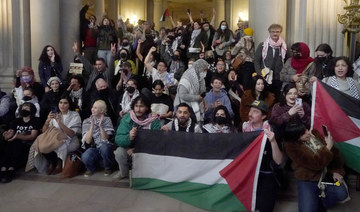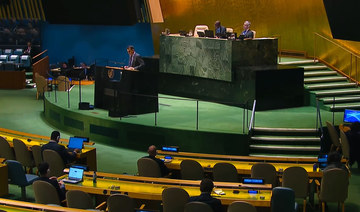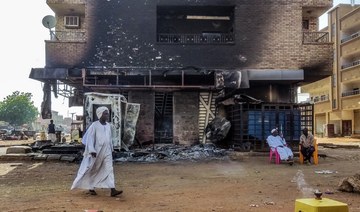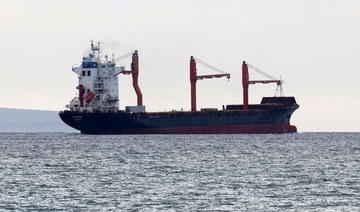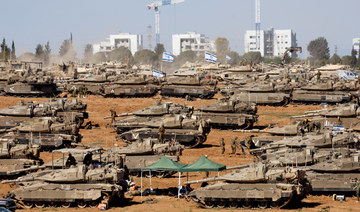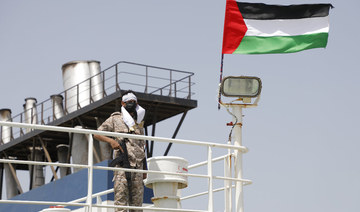BEIT RIMA, West Bank: Security camera video from a West Bank village shows a young man standing in a central square when he is suddenly shot and drops to the ground. Two others rushing to his aid are also hit, leaving a 17-year-old dead, moments before Israeli military jeeps roll in.
An Associated Press review of the video and interviews with the two wounded survivors showed Israeli soldiers opened fire on the three when they did not appear to pose a threat. One of the wounded Palestinians was shot a second time after he got up and tried to hop away.
The fatal shooting in the village of Beit Rima last week is the latest in a series of incidents in which soldiers appeared to fire without provocation, a trend Palestinians say has worsened since the outbreak of the Israel-Hamas war in Gaza three months ago.
The Israeli military said troops entered Beit Rima overnight Thursday into Friday as part of a “counter-terrorism operation.” It said troops fired at suspects who threw explosives and firebombs at them.
The video, obtained by the AP from a local smoke shop, does not show anyone throwing explosives.
After reviewing the footage, a military spokesperson said soldiers reported that one of the Palestinians — visible kneeling in front of an object just outside the frame — was igniting a Molotov cocktail when he was shot.
The video, however, shows that the first shot does not hit the kneeling man, but rather another Palestinian man, Nader Rimawi. Nader told the AP that the object was a stack of cardboard boxes and scraps of paper that 17-year-old Osaid Rimawi had gathered and was preparing to light to keep the men warm.
Other videos of the shooting posted to social media and reviewed by AP appear consistent with Nader’s description of the object Osaid was preparing to light. It is possible videos taken from other angles could further illuminate what happened.
In interviews with the AP, the wounded village residents denied having thrown explosives and said the shootings, about 2 a.m. Friday, were unprovoked.
Two of the six Rimawi brothers were in the town square when word spread that Israeli soldiers were in the village. They said they were aware of the army presence, but that there had been no confrontations. “We were with the young men standing at the roundabout of the town,” said Mohammed Rimawi, 25. “We started looking around as we were standing and not doing anything.”
The half-hour security camera video begins about 20 minutes before the shootings with men gathering in small groups, walking in and out of the frame as cars come and go. Some men gesture elsewhere in the village.
The crowd in the frame eventually thins to under 10 men. Then they scatter as a shot hits Mohammed’s brother, 29-year-old Nader, in the left leg.
The video shows Mohammed running to help before being shot.
“We saw a sniper who started shooting. He shot him. I went to help him. Then he shot me,” said Mohammed, who was struck by a bullet in his right hip.
The video shows Osaid rushing to aid them as he slips something into his pocket. He is quickly shot and later dies of his wounds. His brother, Islam Rimawi, later told AP that he found a lighter, 20 shekels ($5.36), and a pack of cigarettes in Osaid’s pocket.
Mohammed was able to crawl away, but the other two were left rolling on the ground. Nader stood up and attempted to hop away, before again collapsing to the ground. Speaking from his hospital bed days later, Nader said he collapsed after being shot in his right leg.
Apart from Israeli troops carrying guns, no weapons are visible throughout the video. The shooter is not visible either.
The video showed four armored Israeli vehicles arriving about 2 minutes after the shooting and roughly a dozen soldiers getting out, guns prone. They gathered around Mohammed. One soldier prodded Osaid with his foot. Within 4 minutes, the soldiers left the wounded Palestinians on the ground and drove away, ignoring the stack of boxes and declining to arrest them.
Another video of the shooting reviewed by the AP shows the stack of boxes is then toppled by a Palestinian car rushing to evacuate the wounded.
Shortly after, Osaid — a high school student studying to become a barber — was pronounced dead at a nearby hospital.
The military spokesperson said that there were other instances where Palestinians had thrown Molotov cocktails at the forces in Beit Rima that night but said he did not know when. The men shot in the video said this was the only altercation in Beit Rima they were aware of that night.
The military did not respond when asked if soldiers had violated military policy and did not say whether there would be an official investigation.
The Israeli rights group B’Tselem said that even if questionable shootings are caught on camera and investigated by the military, they rarely result in indictments.
“Cases like these happen quite regularly, but no one’s hearing about them,” said Dror Sadot, a spokesperson for the group. “The military will say that it is opening an investigation. And this investigation will last for years, probably without any media covering it. And then it will be washed down the drain.”
In response to Sadot’s allegation, a military spokesperson provided this statement: “Each investigation file is examined according to its circumstances. In the appropriate cases, various enforcement measures are taken, including the filing of indictments.”
Human rights groups have previously presented cases in which soldiers opened fire without their lives being in danger, in apparent violation of the military’s rules of engagement. In most cases, the victims were Palestinians, but Israelis have also been killed in high-profile shootings during the war.
In December, three Israeli hostages who had escaped their Hamas captors in Gaza waved white flags and shouted for help in Hebrew before being gunned down by soldiers.
Sadot said her organization has seen an unprecedented level of violence from soldiers and settlers in the West Bank since the war broke out. The West Bank is experiencing one of the deadliest phases on record, according to United Nations monitors.
Beit Rima resident Ahmed Rimawi, whose two brothers were wounded in the shooting, said he believes soldiers have become more aggressive since the start of the war. In the past, they would initially fire stun grenades to disperse crowds in the village. Now, he said, “they open fire directly on people.”
Palestinian health officials said 340 Palestinians have been killed in the three tense months since Hamas militants attacked southern Israel and killed about 1,200 people, mostly civilians.
The Hamas attack prompted Israel to wage a blistering air and ground campaign on the Gaza Strip that has killed over 23,000 people — and to tighten its grip on the West Bank through near-nightly, often deadly, raids. Israel says the crackdown is aimed at Hamas and other militant groups.
Mohammed and Nader are recovering from their wounds. Both normally work at a factory in a nearby Palestinian village, packaging prepared salads for market. They said they won’t work again until they are able to walk.
Nader underwent surgery Sunday for injuries to his thigh. Mohammed has been released from the hospital but is unable to put weight on his right leg. He limps around the family’s small ornate home in Beit Rima — a village of about 4,000 people north of the city of Ramallah — with the aid of a metal walker.
Back at the village roundabout, the walls are plastered with the weathered faces of local men killed in encounters or clashes with Israeli forces. Among their ranks now appears Osaid’s photograph, gazing over the pockmarked spot in the ground where he was killed.
Video appears to show the Israeli army shot 3 Palestinians, killing 1, without provocation
https://arab.news/6t6sv
Video appears to show the Israeli army shot 3 Palestinians, killing 1, without provocation

- The fatal shooting in the village of Beit Rima last week is the latest in a series of incidents in which soldiers appeared to fire without provocation
ICRC officials to meet UK Foreign Office over plan for Palestinian detainees

- David Cameron reportedly negotiated deal with Israel’s government to allow two British legal observers and Israeli judge to visit some prisoners
LONDON: Officials from the International Committee of the Red Cross will hold talks with the UK Foreign Office over concerns about British plans to visit Palestinian detainees in Israeli jails.
Foreign Secretary David Cameron has reportedly negotiated a deal with Israel’s government to allow two British legal observers and an Israeli judge to visit some prisoners being held in Israeli prisons amid reports of “inhumane treatment,” The Guardian reported on Thursday.
In an interview with the BBC at the weekend, Cameron said he had spoken to Israeli Prime Minister Benjamin Netanyahu about the issue.
“It’s not all bleak ... I said it (the lack of access to detainees) was not good enough, that we needed to have a proper independent system for inspecting and regulating, and the Israelis have announced they are now doing that,” he said.
Netanyahu’s government has blocked ICRC staff from having any access to Palestinian detainees since the Hamas-led attack on Oct. 7. It has said the block will remain until Hamas allows access to Israeli hostages taken during the attack.
Critics say this stance could constitute a breach of the Geneva Conventions, with the ICRC having made repeated requests to both sides in the conflict to allow access to all those detained, as set out in the conventions.
Observers have also raised concerns that the UK plan will “weaken the rule of law” and could set a “dangerous precedent” for how detainees are treated in other conflict zones, The Guardian report added.
The ICRC’s director for the Middle East region, Fabrizio Carboni, is in London to hold talks with Foreign Office officials.
In a statement to The Guardian, the aid organization said Palestinian detainees must be treated as protected persons with access to the ICRC, as proscribed under the Geneva rules.
The statement added: “We have seen the reports of a government of Israel decision to allow observers to visit some places of detention. The ICRC remains hopeful that suitable steps are taken that could protect the health and welfare of detainees, which remains paramount. We reiterate our readiness to resume our mandated detention activities.”
Arab News columnist and director of the Council for Arab-British Understanding, Chris Doyle, said the Foreign Office plan risked establishing a system that bypassed the ICRC and internationally accepted regulations.
“There is no transparency about Cameron’s alternative … I very much doubt that two Foreign Office-appointed lawyers in the company of a judge from the occupying power are going to have the expertise of the ICRC, but will instead be taken around sanitised prisons,” he said.
“What has happened to the thousands of Palestinians taken from Gaza to Israel is a huge issue. (Neither) we nor their families know where they are, whether they are combatants or children, or why in some cases they are being stripped to their underpants. We have heard nothing from the UK government about this,” he added.
During a week-long truce between Hamas and Israeli forces in November, the ICRC played an active role in facilitating the swap of 105 Israeli hostages held by Hamas and 240 Palestinian prisoners from Israeli jails.
Residents cower as fighting picks up in Sudan’s Al-Fashir

CAIRO/DUBAI: Residents are fleeing missile fire and sheltering without food and water amid escalating fighting in the Sudanese city of Al-Fashir, witnesses and aid workers said, adding to fears of an all-out battle.
The city is the Sudanese army’s last stronghold in the western Darfur region. Its capture would be a major boost for the rival Rapid Support Forces (RSF) as regional and international powers try to push the sides to negotiate an end to a 13-month war.
Locals and aid workers fear the clashes could also lead to a new round of bloodletting after ethnically-driven violence blamed on the RSF and its allies elsewhere in Darfur last year.
Many of Al-Fashir’s 1.6 million residents arrived during the violence between Arabs and non-Arabs that killed hundreds of thousands of people in the early-2000s. The RSF’s origins lie in the Arab janjaweed militias accused of ethnic cleansing and genocide then.
In recent weeks the RSF has almost surrounded Al-Fashir, capital of North Darfur state, while soldiers from the army and allied non-Arab armed groups fill the city.
In a sign of mounting ethnic tensions, Mini Minnawi, head of one of the groups, said on X he had made a wide call for fighters to come and defend Al-Fashir, in response to what he said was a similar call by the RSF.
Al-Fashir residents report snipers, stray missiles and army air strikes causing fires in the east and north of the city. Many civilians have taken up arms.
“The situation in the city has been difficult the past few days. Missiles from both sides are falling inside neighborhoods and homes, and getting to hospitals is dangerous,” said 38-year-old resident Hussein Adam.
Medical aid agency MSF said on Thursday that the city’s South Hospital had seen 489 casualties since May 10, including 64 deaths, though it said the real toll was far higher.
Another hospital it supports, which saw 27 people killed last weekend, was forced to shut down after an army air strike 50 meters away, MSF said.
The RSF and army blame each other for the violence.
On Wednesday, the United States imposed sanctions on two top RSF commanders, including the force’s head of operations, for the attacks on Al-Fashir.
“We are prepared to take further action against those who actively escalate this war – including any offensive actions on El Fasher – create barriers to humanitarian access, or commit atrocities,” US ambassador to the United Nations Linda Thomas-Greenfield posted on X.
Experts have raised warnings of impending famine in the displacement camps that dot Al-Fashir. The city also suffers from water shortages, network outages, and high prices.
In one of those camps, Abu Shouk in the north of the city, nine people were killed by stray missiles, camp leaders said on Sunday.
Residents say displaced people from eastern neighborhoods are sheltering under trees and in open squares.
“Most families have moved west, women and children with nothing to eat or drink,” said resident Mohamed Jamal, a volunteer with the local emergency response room.
The army has so far insisted that international aid delivered via Chad for other parts of Darfur pass through Al-Fashir, something that the escalating violence prevents.
Carl Skau, Chief Operating Officer of the World Food Programme, said the agency had trucks ready in the Chadian border town of Tina, but they needed to be able to move soon.
“The window is closing, the rains are coming and we need action in the next couple of weeks,” he told Reuters after a trip to Port Sudan where he tried to negotiate with the army for better access this week.
The UN’s World Food Programme expects more people are being driven to the brink of starvation in other parts of Sudan worst affected by the war including the capital Khartoum, El Gezira state and the Kordofan regions.
“We really need to step up a concerted effort to avoid an even worse catastrophe,” Skau said.
US military says aid pier anchored to Gaza beach

- The US Central Command said the pier was “successfully affixed to the beach in Gaza” with around 500 tons of aid expected to enter the Palestinian territory in the coming days
- “It’s a pretty substantial amount, and it’s spread out over multiple ships right now,” Vice Admiral Brad Cooper, deputy CENTCOM commander, told reporters
JERUSALEM: US troops on Thursday anchored a long-awaited temporary pier aimed at ramping up emergency aid to a beach in the war-ravaged Gaza Strip, the US military and Israel said.
The US Central Command said the pier was “successfully affixed to the beach in Gaza” with around 500 tons of aid expected to enter the Palestinian territory in the coming days.
“It’s a pretty substantial amount, and it’s spread out over multiple ships right now,” Vice Admiral Brad Cooper, deputy CENTCOM commander, told reporters in Washington.
Israel’s military also said in a statement that the connection was “successfully completed.”
But Farhan Haq, a spokesman for UN Secretary-General Antonio Guterres, said negotiations remained ongoing on distribution of the aid — particularly on the safety of workers.
“We are finalizing our operational plans to make sure that we’re ready to handle it once the floating dock is properly functioning, while ensuring the safety of our staff,” he said.
The Gaza war has been devastating for aid workers. The UN agency for Palestinian refugees, UNRWA, which Israel accuses of bias, has alone lost 188 Gaza staff, according to UN figures.
Asked about the concerns, State Department spokesman Vedant Patel said the United States was working with the United Nations on practicalities but added: “From our point of view, we believe that this is ready to go and for aid to start flowing as soon as possible.”
US President Joe Biden announced the emergency pier in March to address the humanitarian crisis in Gaza, where the United Nations has warned of famine with virtually the entire population of 2.4 million displaced by the Israeli military action in response to the October 7 Hamas attack.
Built at a cost of at least $320 million, the project is extraordinary in that such massive humanitarian efforts by the United States are usually in response to actions by hostile countries, not a US ally.
The humanitarian assistance is being screened in Cyprus and loaded by truck. Once on land, it will “move quickly,” being offloaded from the coast into Gaza within hours, Cooper said, adding that “thousands of tons of aid are in the pipeline.”
He said that around 1,000 US soldiers and sailors were involved in the operation but that they would not take part in delivery, which will be led by the UN.
The war began after Hamas’s October 7 attack on southern Israel, which resulted in the deaths of more than 1,170 people, mostly civilians, according to an AFP tally of Israeli official figures.
Israel’s military retaliation has killed at least 35,272 people, also mostly civilians, according to the health ministry in the Hamas-run Gaza Strip.
The UN has argued that opening up land crossing points and allowing more trucks convoys into Gaza is the only way to stem the spiralling humanitarian crisis.
But the primary crossing into Gaza, on the territory’s border with Egypt, has been closed for days.
Israeli troops took over the Palestinian side of the crossing last week as the military threatened a wider assault on the southern city, defying warnings from the United States and others over the fate of some 1.4 million civilians who had been sheltering there.
“Of course we’re thankful to the US for all the work they’ve done in creating the floating dock. However, getting aid to people in need into and across Gaza cannot and should not depend on a floating dock far from where needs are most acute,” Haq said.
Cyprus, the Mediterranean island nation that is the departure point for aid on the planned maritime corridor, said US ship James A. Loux left Wednesday, carrying relief supplies and technical equipment.
Government spokesman Konstantinos Letymbiotis said that “new departures are expected, transporting humanitarian aid including food items, medical supplies, hygiene and temporary shelter.”
Britain, meanwhile, said its initial contribution of nearly 100 tons of “shelter coverage kits” figured in the first shipment.
The pier will begin with facilitating the delivery of around 90 truckloads of international aid into Gaza each day, before volumes are scaled up to 150 truckloads daily, a British statement said.
‘Our supplies will not last,’ warns doctor at trauma center

JERUSALEM: At a field hospital that has become one of Gaza’s leading trauma centers, a doctor who has worked in a dozen war zones described the situation as the most “catastrophic” he had ever seen.
“It is devastating,” said Javed Ali, the head of International Medical Corps’ emergency response in Gaza.
Speaking this week from a field hospital northwest of the areas of Rafah ordered evacuated by Israel, he said the situation around the far southern city was “dire.”
The hospital, in the coastal area of Al-Mawasi, which Israel has designated a “humanitarian zone,” has swelled in a matter of months into a more than 150-bed facility made up of numerous white tents and shipping containers.
Since the first evacuation orders for Rafah were issued on May 6, ahead of a long-feared ground invasion of the southernmost part of Gaza, nearly half of the 1.4 million people who had been sheltering there have left, according to UN agencies.
“There has been a massive population movement,” Ali said, adding that most had avoided Al-Mawasi, which was already dramatically overcrowded, heading instead for the war-scarred city of Khan Younis, a battleground until last month.
Those arriving were “exhausted, they are scared, they don’t have resources,” Ali said, adding that many patients were asking for “money, support ... so they can move their families to safety.”
Gaza’s bloodiest war began with Hamas’s unprecedented Oct. 7 attack on Israel.
Israel’s retaliatory offensive has killed more than 35,000 people in Gaza, mostly civilians, according to the territory’s Health Ministry.
While the number of people sheltering in Al-Mawasi’s sea of tents may not have grown much in recent weeks, the pressure on the field hospital there certainly has.
With access to hospitals in Rafah largely cut off, the facility has seen the number of daily visits to its emergency department balloon from around 110 to close to 300, Ali said, describing “polytrauma cases with broken bones in every part of the body.”
The situation has been exacerbated by last week’s temporary closure of two major aid crossings into Rafah, which disrupted the supply of medicines and fuel for hospital generators.
Ali said the field hospital “saw this coming” and prepared surplus stocks but had not predicted the surging number of patients.
“It’s getting totally out of hand,” he said. “Our supplies will not last.”
He said the field hospital already saw shortages of “very critical items.”
It had, for instance, run out of “all pediatric formulations of antibiotics and painkillers” at a time when around 20 children were recovering from surgery.
Ali said the biggest worry was “space,” with major surgeries doubling from the previous average of around 25 a day.
There has also been a dramatic rise in the workload of the maternity ward, which has gone from around 10 deliveries a day to about 25, along with up to eight C-sections.
With expectant mothers unable to access the specialist maternity hospital in Rafah, there has also been a “massive increase in the number of complicated pregnancies,” he said.
Ali, who during a 15-year career has worked in war zones from Afghanistan and Sudan to Nigeria and Ukraine, said the situation in Gaza was “far more catastrophic.”
“The immense number of trauma cases, the lack of resources, the interrupted supply chain ... It’s something that I’ve never seen.”
In most wars, men account for the majority of gunshot and shrapnel wounds, but in Gaza the number of women and children injured “is very, very high,” Ali said, describing young children “with shattered limbs.”
With only a third of Gaza’s 36 pre-war hospitals even partially functional, according to the UN, and with displaced people often stuck far from health facilities “access has become extremely compromised.”
Ali said the field hospital in Al-Mawasi has grown to be the “main trauma referral center” in southern Gaza, “and we are working in a tent.”
US destroys 4 Houthi drones in Yemen

- CENTCOM: These actions are taken to protect freedom of navigation and make international waters safer and more secure for US, coalition, and merchant vessels
- Prime minister accuses militia of trying to bankrupt the government by attacking oil terminals
AL-MUKALLA: The US Central Command said on Thursday morning, Yemen time, that its forces had destroyed four drones in an area controlled by the Houthi militia, thwarting a strike on ships in international commercial waterways.
“These actions are taken to protect freedom of navigation and make international waters safer and more secure for US, coalition, and merchant vessels,” CENTCOM said in a statement.
This is the latest round of US military operations against sites in Yemen under Houthi control to pre-emptively destroy drones and missiles before they can be used against commercial and navy ships in the Red Sea, Bab Al-Mandab Strait and Gulf of Aden.
The CENTCOM announcement came as Houthi officials reaffirmed their warnings to expand their assaults on ships if Israel did not halt its war in the Gaza Strip.
Mahdi Al-Mashat, leader of the militia’s Supreme Political Council, said that they will launch attacks on ships during the fourth phase of their campaign in support of Palestine, which involves targeting ships in the Mediterranean until Israel ends the war and the blockade of Gaza.
“We have decisive, bold, and difficult choices if the aggression against our people in Gaza continues,” Al-Mashat said, according to the Houthi-run Saba news agency.
The militia’s leader, Abdul Malik Al-Houthi, said on Thursday that his forces had fired 211 missiles at Israel and carried out more than 100 attacks on US warships in the Red Sea since the start of their campaign in November.
He urged Iraqis to join them in their operations to support the Palestinian people.
“Companies that transport goods to the Israeli enemy will have their ships attacked anywhere within reach of the Yemeni army's capabilities,” Al-Houthi said.
Since November, the Houthis have destroyed one commercial ship, captured another, and launched hundreds of ballistic missiles and drones at commercial ships and warships along international shipping lanes near Yemen, mostly in the Red Sea.
The Houthis say the attacks are intended to compel Israel to halt its blockade of Gaza, and have targeted US and UK ships because both countries attacked Yemen.
Yemeni government officials accuse the Houthis of leveraging Yemen’s widespread anger over Israel’s war in Gaza to shore up their dwindling popular support, recruit new fighters, and justify continuing military operations throughout Yemen.
Speaking to leaders at the Arab summit in Bahrain on Thursday, Rashad Al-Alimi, head of Yemen’s internationally recognized Presidential Leadership Council, branded the Houthis as a “rogue” force that poses a significant danger to regional and international security.
He accused the Houthis of killing more than 500,000 Yemenis, displacing four million more, torching hundreds of homes and mosques, besieging towns, seizing Yemeni property, and generating the world’s greatest humanitarian catastrophe.
“The Yemen war, which was instigated a decade ago by Iran-backed militia, will continue to be one of the biggest challenges to Arab nations and their people’s interests,” Al-Alimi said.
At the same time, Yemen’s Prime Minister Ahmed Awadh bin Mubarak accused the Houthis of attempting to bankrupt his government by attacking oil terminals in the government-controlled provinces of Hadramout and Shabwa, preventing traders from importing goods through Aden ports, while banning the import of gas from the central city of Marib.
He said that the Houthis’ efforts, which he described as an economic war, had cost the Yemeni government 3.3 trillion Yemeni riyals ($13.2 billion) in lost income since October 2022.
“The Houthis are using all of their cards, including the economic war, to accomplish political goals,” bin Mubarak said in an interview with the national TV on Wednesday.




